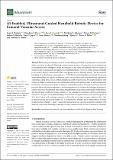| dc.contributor.author | Brattain, Laura J. | |
| dc.contributor.author | Pierce, Theodore T. | |
| dc.contributor.author | Gjesteby, Lars A. | |
| dc.contributor.author | Johnson, Matthew R. | |
| dc.contributor.author | DeLosa, Nancy D. | |
| dc.contributor.author | Werblin, Joshua S. | |
| dc.contributor.author | Gupta, Jay F. | |
| dc.contributor.author | Ozturk, Arinc | |
| dc.contributor.author | Wang, Xiaohong | |
| dc.contributor.author | Li, Qian | |
| dc.contributor.author | Telfer, Brian A. | |
| dc.contributor.author | Samir, Anthony E. | |
| dc.date.accessioned | 2022-01-03T18:03:45Z | |
| dc.date.available | 2022-01-03T18:03:45Z | |
| dc.date.issued | 2021-12-18 | |
| dc.identifier.uri | https://hdl.handle.net/1721.1/138783 | |
| dc.description.abstract | Hemorrhage is a leading cause of trauma death, particularly in prehospital environments when evacuation is delayed. Obtaining central vascular access to a deep artery or vein is important for administration of emergency drugs and analgesics, and rapid replacement of blood volume, as well as invasive sensing and emerging life-saving interventions. However, central access is normally performed by highly experienced critical care physicians in a hospital setting. We developed a handheld AI-enabled interventional device, AI-GUIDE (Artificial Intelligence Guided Ultrasound Interventional Device), capable of directing users with no ultrasound or interventional expertise to catheterize a deep blood vessel, with an initial focus on the femoral vein. AI-GUIDE integrates with widely available commercial portable ultrasound systems and guides a user in ultrasound probe localization, venous puncture-point localization, and needle insertion. The system performs vascular puncture robotically and incorporates a preloaded guidewire to facilitate the Seldinger technique of catheter insertion. Results from tissue-mimicking phantom and porcine studies under normotensive and hypotensive conditions provide evidence of the technique’s robustness, with key performance metrics in a live porcine model including: a mean time to acquire femoral vein insertion point of 53 ± 36 s (5 users with varying experience, in 20 trials), a total time to insert catheter of 80 ± 30 s (1 user, in 6 trials), and a mean number of 1.1 (normotensive, 39 trials) and 1.3 (hypotensive, 55 trials) needle insertion attempts (1 user). These performance metrics in a porcine model are consistent with those for experienced medical providers performing central vascular access on humans in a hospital. | en_US |
| dc.publisher | Multidisciplinary Digital Publishing Institute | en_US |
| dc.relation.isversionof | http://dx.doi.org/10.3390/bios11120522 | en_US |
| dc.rights | Creative Commons Attribution | en_US |
| dc.rights.uri | https://creativecommons.org/licenses/by/4.0/ | en_US |
| dc.source | Multidisciplinary Digital Publishing Institute | en_US |
| dc.title | AI-Enabled, Ultrasound-Guided Handheld Robotic Device for Femoral Vascular Access | en_US |
| dc.type | Article | en_US |
| dc.identifier.citation | Biosensors 11 (12): 522 (2021) | en_US |
| dc.contributor.department | Lincoln Laboratory | |
| dc.identifier.mitlicense | PUBLISHER_CC | |
| dc.eprint.version | Final published version | en_US |
| dc.type.uri | http://purl.org/eprint/type/JournalArticle | en_US |
| eprint.status | http://purl.org/eprint/status/PeerReviewed | en_US |
| dc.date.updated | 2021-12-23T15:06:57Z | |
| dspace.date.submission | 2021-12-23T15:06:57Z | |
| mit.license | PUBLISHER_CC | |
| mit.metadata.status | Authority Work and Publication Information Needed | en_US |
